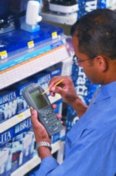How the New FDA Bar Code Rule Can Impact Drug Packaging
 The US Food and Drug Administration (FDA) is rethinking their 2004 bar code rule on drug packaging which could significantly impact pharmaceutical manufacturers and medical institutions. Due to increasing instances of counterfeit drugs, the FDA is thinking of using serialized 2-dimensional bar codes in addition to or instead of the linear bar codes used in packages and labels today. The 2-dimensional bar codes makes it possible to track and trace the units through different distribution channels. Complying with this change could cost pharmaceutical manufacturers and medical institutions up to $200,000 in upgrading equipment.
The US Food and Drug Administration (FDA) is rethinking their 2004 bar code rule on drug packaging which could significantly impact pharmaceutical manufacturers and medical institutions. Due to increasing instances of counterfeit drugs, the FDA is thinking of using serialized 2-dimensional bar codes in addition to or instead of the linear bar codes used in packages and labels today. The 2-dimensional bar codes makes it possible to track and trace the units through different distribution channels. Complying with this change could cost pharmaceutical manufacturers and medical institutions up to $200,000 in upgrading equipment.
Since 2004, the FDA has required all pharmaceutical manufacturers to print a linear bar code containing the drug's National Drug Code (NDC) on the label or on the package. Marking drugs with bar codes was implemented to avoid giving patients the wrong medicine. Medical professionals can scan the bar code at the hospital bedside before giving medication to make sure that the correct drug is given to the correct patient. But linear bar codes do not have the capacity to store much more data than the NDC. Important information such as expiration date and lot number do not fit in the linear bar codes. In cases of bad lots or counterfeit drugs, tracking the individual units is difficult. By using 2-dimensional bar codes, which can hold more data, additional information can be encoded, making it easy to track and trace the drugs through distribution channels.
Counterfeit drugs are a huge problem in the medical industry. Counterfeit medicine is estimated at $200 billion or 10% of the worldwide pharmaceutical trade. Just this year, 19 medical clinics in the United States were found to be using counterfeit Avastin, a life-saving cancer drug used to treat brain, kidney, lung and colon cancer. The fake drug does not contain the active ingredient in Avastin and instead was made of acetone, salt, starch and other fillers. The counterfeit Avastin is packaged as Altuzan, the Turkish brand of the drug, and is thought to come from Egypt, Turkey, Switzerland, Denmark and the United Kingdom. Because drugs today do not have the lot numbers in the bar code, it is difficult to find out where exactly these units came from. It is also difficult to recall all the counterfeit medicine that has already been given to patients.
California has already enacted an e-Pedigree requirement to combat counterfeit drugs. Starting in 2015, all drugs need to have a serialized 2-dimensional (2D) GS1 DataMatrix bar code on their packages that include a lot number, a unique serial number and other information. This new bar code can be used instead of or in addition to the existing linear bar code. The GS1 bar code allows the drugs to be tracked and traced through the distribution chain by using software, scanners and databases.
"The complicating factor is that e-Pedigree is the most technically onerous of the traceability modes that are being discussed worldwide, so California's law sets the bar very high," Mark Davison, CEO of Blue Sphere Health and author of Pharmaceutical Anti-Counterfeiting: Combating the Real Danger from Fake Drugs, said. "If some kind of compromise nearer to the European model could be reached then it might be easier to gets things done federally."
The European Union (EU) is expected to replicate California's requirements as early as 2013. Datamatrix is already required in countries such as Korea, India, Turkey, France and Argentina. However, France only requires batch-level serialization.
GS1 is an international standards organization that provides GS1 DataMatrix, a type of 2D bar code that can hold up to 1566 bytes of data most popularly used to mark small items for track and trace purposes, and GS1 DataBar, a small pyramid of stacked linear bar codes. GS1 allows for serialization within its Global Trade Identification Number (GTIN). At the moment, only a few pharmaceutical manufacturers use GS1 DataMatrix. Some are already using the GS1 DataBar, but not serialized.
Drug manufacturers would need to upgrade their equipment throughout the packaging and distribution lines to be able to use serialized bar codes. Serialization means that the drug needs to have a unique serial number on the package. The serialized bar codes on each unit need to be linked to the carton, which also need to be linked to the pallet. Depending on the speed of the equipment, upgrading costs from $60,000 to $200,000 for new printers, scanners, controllers and software, as well as upgrading back office enterprise resource planning (ERP) systems.
It is not just drug manufacturers that are going to be affected by the change. Hospitals and medical clinics would also need to update their equipment such as software, scanners and databases to be able to read the GS1 bar codes. Most hospitals today use linear laser-based scanners to scan linear bar codes that contain NDC codes. But reading GS1 bar codes require camera-based scanners.
Other articles by this author:
DNA Barcoding the International Barcode of Life
Best Phone Apps for Health and Nutrition
Best Mobile Coupon Apps for Groceries
{jcomments on}
